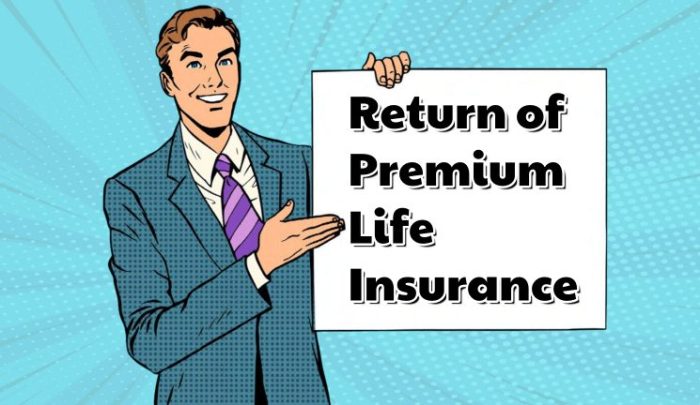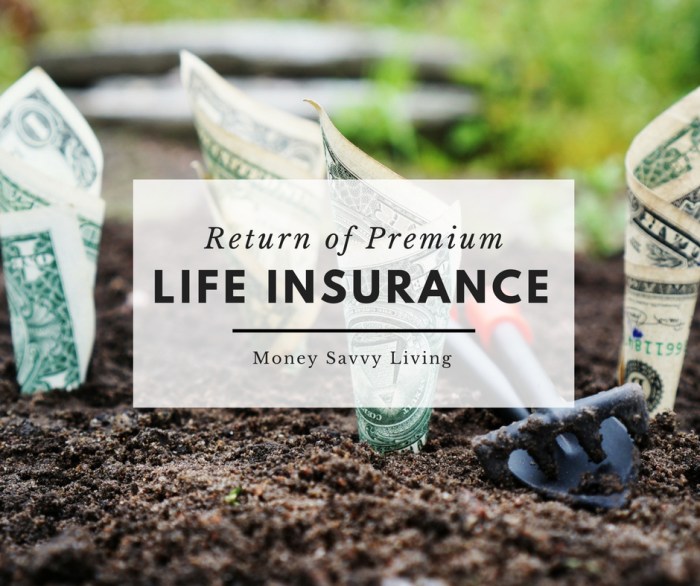Return of Premium (ROP) life insurance offers a unique blend of life insurance protection and a potential financial return. Unlike traditional policies, ROP plans promise to refund all or a portion of your premiums if you outlive the policy term. This intriguing feature makes it a compelling alternative for those seeking both coverage and a potential financial reward. This guide delves into the intricacies of ROP life insurance, exploring its mechanics, costs, benefits, and suitability for various life stages.
We’ll examine how ROP policies function, comparing them to term and whole life insurance. We’ll also analyze the financial implications, including cost considerations and potential tax benefits, to help you make an informed decision about whether this type of policy aligns with your individual financial goals and risk tolerance. By understanding the nuances of ROP insurance, you can determine if it’s the right choice for securing your future and potentially recovering your premium payments.
Illustrative Examples and Case Studies

Return of premium (ROP) life insurance policies offer a unique value proposition, but their suitability depends heavily on individual circumstances and financial goals. Understanding how these policies perform in different scenarios is crucial for making an informed decision. The following examples illustrate both the potential benefits and limitations of ROP policies.
A Hypothetical Individual Benefiting from a Return of Premium Policy
Consider Sarah, a 35-year-old professional with a stable income and a young family. She purchases a 20-year ROP term life insurance policy with a substantial death benefit. Over the policy’s duration, she diligently pays her premiums. Should she remain healthy and live beyond the 20-year term, the insurance company returns all her premiums, totaling a significant sum. This amount could then be used for retirement planning, funding her children’s education, or other significant life goals. This scenario highlights the potential for a ROP policy to act as both life insurance and a form of long-term savings.
A Scenario Where a Return of Premium Policy Might Not Provide Significant Benefits
Conversely, imagine John, a 60-year-old retiree on a fixed income. He purchases a 10-year ROP policy. While the death benefit provides peace of mind, the probability of him receiving the return of premiums is lower than for a younger individual. The premiums, while potentially manageable, might represent a larger proportion of his limited income compared to Sarah’s situation. The return of premiums, if received, might be less impactful given his age and shorter time horizon for utilizing the funds. The cost of the policy, relative to a traditional term life insurance policy with a similar death benefit, could also be a significant factor.
Financial Impact of Choosing a Return of Premium Policy Over a Traditional Policy
Let’s compare two policies with a $500,000 death benefit over a 20-year term. A traditional term life insurance policy might have an annual premium of $1,000, totaling $20,000 over 20 years. A comparable ROP policy might have an annual premium of $1,500, totaling $30,000 over 20 years. While the ROP policy costs $10,000 more in premiums, it offers the potential to recoup that entire amount if the policyholder survives the term. The decision hinges on the individual’s risk tolerance and assessment of the likelihood of receiving the premium return. A younger individual with a longer life expectancy might view the higher premium as a worthwhile investment for the potential return, whereas an older individual might prioritize the lower premium of a traditional policy.
Visual Representation of Growth and Return of Premiums Over Time
A simple line graph could visually represent this. The x-axis would represent the years (0-20), and the y-axis would represent the accumulated premium paid. A steadily increasing line would show the growth of premiums paid over time. At the 20-year mark, the line would abruptly level off, then a horizontal line would show the return of all premiums, indicating the full return if the policyholder survives the term. If the policyholder dies within the term, the death benefit would be shown as a separate, significantly higher point above the premium line.
Conclusion

Return of Premium life insurance presents a compelling proposition for those seeking both life insurance protection and the potential for a premium refund. While it may not be the optimal solution for everyone, understanding its mechanics, costs, and suitability within your specific financial circumstances is crucial. By carefully weighing the advantages and disadvantages, and considering the long-term financial implications, you can make a well-informed decision that aligns with your individual needs and risk tolerance. Ultimately, the decision rests on your individual financial goals and the level of risk you are willing to accept.
Helpful Answers
What happens if I die during the policy term?
Your beneficiaries will receive the death benefit, as with any life insurance policy, regardless of premium refunds.
Are there any health requirements for ROP insurance?
Yes, insurers will assess your health to determine eligibility and premiums, similar to traditional life insurance.
Can I withdraw from the policy before the term ends?
Typically, withdrawing early will likely forfeit the return of premium benefit, and you may receive a reduced cash value.
How are premiums returned?
The method varies by insurer, but it’s usually a lump-sum payment upon policy expiration if you are still living.
Is ROP insurance more expensive than traditional term life insurance?
Generally, yes, ROP insurance premiums are higher due to the added benefit of potential premium return.